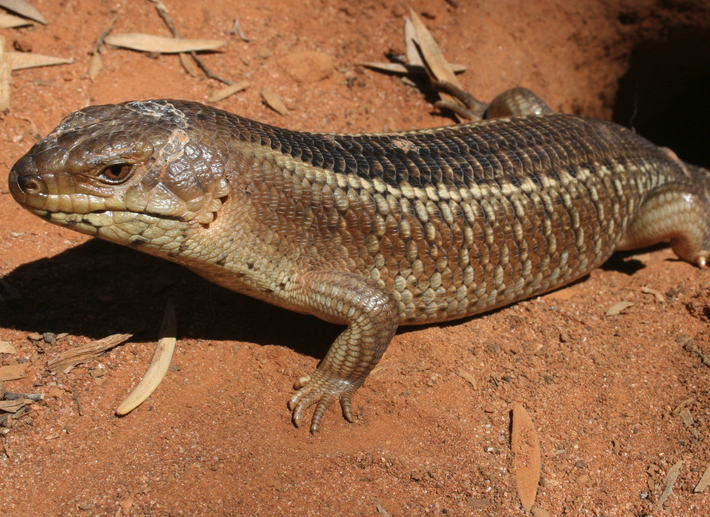
Report on Stephen Peck’s talk – Yakka Skinks, held on 19 August 2024, by Ron Carr
Stephen Peck, known as “Pecky, is a National Parks and Wildlife Ranger with many years of experience. He is currently a PhD candidate and has been studying these fascinating creatures for some 20 years. He does so persistently and thoroughly despite a lack of funding and resources being directed towards what are sometimes described as our “iconic” species. QNC thanks Pecky for enabling us to see at some depth into the lives of these complex social creatures.
The yakka skink is a large lizard that can grow up to 440mm in length and weigh up to 400g. Their size is similar to shingle backs and land mullets. The adult size is at the upper limit as a prey species for feral cats, but the perfect size for the red fox. Sub-adults are highly vulnerable to predation by either species. The diet of young skinks comprises mostly insects but as they age there is an increased proportion of grass and leaf material.
The skinks are limited in distribution to the Brigalow Belt and the Mulga Lands ofQueensland. Unfortunately, these are the 2 Bioregions most severely impacted by land clearing for grazing purposes.
The fire regime followed in a particular locality is often determinative of the skink’s ability to survive. In a particular study site where native grasses had not been burnt for 60 years or so, there was quite a heavy buildup of small and large logs on the ground with the larger ones providing accommodation and the smaller logs providing shelter. It had good coverage of skink communities. In nearby areas of what would have been similar habitat, but for a more regular fire regime of light burns of native grasses, few skinks were to be found. In other areas where native pastures had been replaced (or as they say “improved”) by buffel grass (Cenchrus ciliaris), no skinks could be found.
Yakka skinks are deeply attached to place. They will persist at a location despite disturbance and will remain for decades. They are long lived, have a slow reproductive rate and take six years to reach sexual maturity. They are live bearers and have a maximum of six in a litter with the neonates being surprisingly large at approximately 180mm in length and weighing 20 to 30g. Population studies demonstrate very low numbers of animals younger than 60 months but better numbers for animals above that age. Thispoints to the severity of predation prior to reaching adulthood, but with those animals surviving to adulthood then going on to a long life there is an accumulation of numbers in the older group. An individual captured as an adult, (older than 60 months) was recaptured 14 years later still going about its daily routine.
Even from birth baby Yakka skinks will contribute to a single scat pile which will serve the whole community. The species show a very low rate of dispersal and where dispersal has occurred it has been over short distances of approximately 50m. This can limit their ability to disperse into adjacent areas. Given these factors it is perhaps unsurprising that these skinks are social animals with a colony inhabiting its own small area for decades or perhaps longer if undisturbed. They will occupy rabbit warrens or hollow logs. They like an open habitat, they do not climb and do not seem to like particularly rocky environments. All of this tilts the odds in favour of the feral cats and foxes.
Camera surveillance seems to indicate that the skinks are unfazed by birds and even a squadron of apostle birds engaged in mobbing behaviour left the skinks still enjoying lying in the sun on their logs and on open ground. Similarly, they are quite unafraid at the presence of sand goannas which walk through their territory. However, there are filmed interactions showing a 40cm skink standing up and advancing toward a 150cm sand goanna, and even engaging in combat by daring to bite its tail. In one instance the normally sluggish, slow-moving skink puts to flight a large sand goanna and chases it at surprisingly high speed for a distance of 25m! Their general disposition seems to belie the name “Yakka” (meaning hard work in some native languages). Curiously that word is not included in any of the Indigenous languages within the skink’s distribution range.
Comic irony might be a possible explanation.
